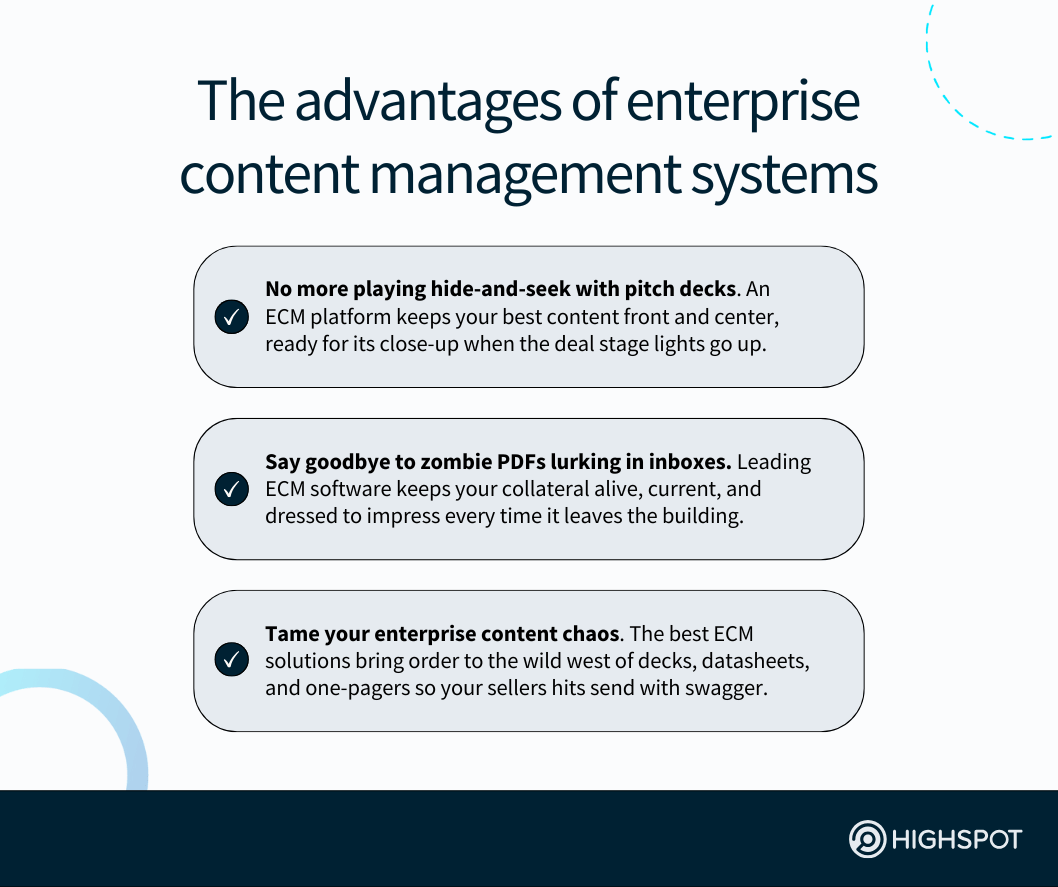Key Takeaways
- Enterprise content management (ECM) centralizes how B2B teams organize, govern, and deliver content, making it easier to ensure assets are current, compliant, and connected to go-to-market (GTM) success.
- The best ECM systems are more than just records management software. These platforms also empower GTM teams to align messaging, track usage, and scale the impact of marketing and enablement assets.
- Your ECM solution should ultimately deliver more intelligent information management, using AI to automate governance, surface relevant collateral, and tie assets back to revenue-driving actions and outcomes.
We’re living in a content revolution.
Every team creates it. Every customer generates it. And most companies are buried under it. From paper contracts in filing cabinets, to digital assets scattered across shared drives and inboxes, content multiplies faster than you can manage it.
As volumes grow, the challenge isn’t producing more of it, it’s taking control of your content management. Deloitte Digital found a 54% increase in the amount of content that organizations needed to produce in just one year.
Yet most enterprises still lack the systems to manage it, with the Content Marketing Institute stating that only 22% of scaled businesses claim to have effective content management technology. More than half cite missing capabilities such as workflow management, data-driven decision-making, and analytics.
A company’s size doesn’t dictate the quality of its content management, of course.
Many large companies still rely on outdated systems or, worse, paper records, when they could be digitizing, categorizing, and automating their processes to improve efficiency and eliminate the need for other systems.
That’s where enterprise content management comes in: to put an end to the sales content chaos, provide a central location for critical information and assets across go-to-market systems, and make every piece of collateral a valuable asset for your business decision-making—including deal discussions.
The go-to-market enablement team over at Motus details how it improved its enterprise content management (ECM) with Highspot, making it easier for sellers and marketers to find, share, update, retire, and use assets.
What is enterprise content management (ECM)?
Enterprise content management (ECM) combines process and technology to capture, store, organize, and deliver all types of business content, including paper documents and electronic files, to reduce organizational risk and make it easier for relevant teams to access enterprise content for various use cases.
Traditional ECM systems are simple static document management tools.
Today’s ECM or content services platforms (CSPs) are cloud-based, integrated with other apps—including Microsoft Office documents and CRM and ERP systems.
What’s more, leading ECM tools support information governance and use leading AI and machine learning capabilities to automate workflows, manage info, make sense of massive amounts of unstructured content, and improve search.
For example, ECM can route a new contract for review and approval or trigger an update when a PO is finalized. Similar business processes can be further streamlined by storing documents in a single source of truth for multiple departments.

Why GTM teams need an enterprise content management system
Go-to-market teams must provide quick access to accurate, up-to-date collateral.
Implementing an ECM solution eliminates ad-hoc processes by centralizing all sales and marketing assets in one, single digital asset management workspace.
Sales reps are able to find what they need faster, marketing controls versions, and sales leaders see how content influences sales pipeline and revenue.
By centralizing info and applying governance controls (like role-based permissions), version tracking, and audit trails, ECM helps manage risk, maintain compliance, and ensure consistent messaging across all customer-facing functions.
Highspot’s State of Sales Enablement Report 2025 found businesses with well-integrated enablement tech stacks are 42% more likely to increase sales productivity and 28% more likely to feel confident measuring the performance of their GTM initiatives.
Together, these findings underscore the importance of unified and intelligent content management software that seamlessly integrates assets, analytics, and execution across the entire go-to-market motion—and their downstream impact of helping sales representatives provide stellar customer experiences.
How modern ECM platforms work today
A robust ECM system consolidates an organization’s content from multiple sources into a single technology system. Documents may include scanned paper records, electronic forms, digital documents, web content, research reports, purchase orders, and emails.
The system’s store component acts as a secure repository for managing documents, while metadata indexes unstructured information for fast search, retrieval, and routing through business processes such as review, approval, and archiving.
What are the top enterprise content management tools?
The best ECM software depends on your needs and where your docs live. Prioritize tools that integrate with your existing tech stack, strengthen security, and are easy of use.
Look for ECM vendors that combine document capture, records management, enterprise sales enablement capabilities, search, analytics, and collaboration features.
For example, an ECM platform, when integrated directly with your CRM, can automatically attach approved proposals or contracts to customer records, while integration with Microsoft 365 enables teams to co-edit documents in real-time.
Integration with IBM Cloud Paks extend those capabilities by automating document workflow, extracting data from forms, and enforcing compliance. Everything is then saved back to the ECM for version control and audit history.
Building an effective ECM strategy for your GTM teams
Each step below helps you tame content chaos while also strengthening information governance and planning a successful ECM implementation.
Control content access with roles and permissions
Set clear roles for who can store, edit, or share documents.
Role-based permissions safeguard sensitive data, support compliance with corporate policies, and ensure the right teams have the right information at the right time.
For example, your legal team might have edit rights on contracts, while sellers on your GTM team only have access to the final, approved versions signed by customers.
Retire outdated files automatically
Set expiration dates to archive or remove obsolete materials. Automated content lifecycle management prevents dated messaging from circulating and keeps your repository current.
When employees save files on their desktops or share outdated versions via email, it creates confusion, especially when new pricing updates or legal terms are introduced.
Getting everyone in GTM on board with centralized version control eliminates that risk and ensures sellers always use the most current, approved materials.
A quarterly ‘content hygiene’ review should include marketing, enablement, product, accounts payable, and legal to determine which assets to retire, update, and keep in ‘rotation,’ based on usage data and upcoming GTM campaigns.
These audits safeguard account backups and maintain a lean, searchable library.
Use smart tags for fast, intelligent discovery
Tag assets with metadata such as industry, persona, or stage in the buyer journey. With machine learning, ECM tools can even auto-apply tags to new uploads.
This not only saves time but also makes it easier for sales reps (and any other searchers) to find content by context rather than by exact filename.
For example, a rep searching “renewal playbook” could instantly find a template, case study, and pricing sheet associated with product renewals and expansion across departments.
With smart tagging and AI, modern ECM platforms do just that: Turn scattered, disparate content into a searchable, intelligent library sellers can trust.
Standardize naming conventions for consistency
Clear, consistent file names with standardized naming conventions help you instantly recognize specific documents and reduce duplication. Establish a simple format, such as Product_Overview_Q2_2025.pdf, and train your teams to follow it.
This is a small but meaningful discipline that creates massive downstream efficiency when there is a growing need for managing docs across teams or regions.
Track content engagement and performance
Sales content analytics turn content usage into valuable insights. Engagement scorecards or dashboards show how buyers interact with materials, including open rates, time spent, and follow-up actions.
While analytics may highlight correlations to pipeline progress, it’s essential to interpret those results as indicators rather than direct causation.
For example, an asset with high engagement at late deal stages likely met a buyer’s need in that moment, not necessarily the only reason the deal advanced.
Pairing ECM analytics with a sales asset management solution enables GTM leaders to identify which content supports buyer engagement and which requires refinement.
Connect ECM with CRM for contextual content
Integrating your ECM platform with CRM systems, such as Salesforce, provides content in context, allowing your sellers to see the most relevant assets within each opportunity.
This seamless integration is foundational to B2B sales enablement.
With it, every touchpoint will have content that feels timely and consistent.
“While the modern buyer wants a personalized experience, they also want one that safeguards their data and prevents potential risk,” Highspot’s State of Sales Enablement Report 2025 explains. “To supply both, organizations are choosing vendors that offer access-restricted digital sales rooms designed to progress deals faster without sacrificing a buyer’s security or trust.”
This balance between personalization and privacy helps B2B sellers—like yours—build trust with buyers, which may even accelerate deal cycles.
Enforce brand compliance policies
Automated workflows guide assets through the exact process you define, ensuring every asset meets brand, legal, and regulatory standards before publication.
A sales content governance process will help reduce regulatory compliance risks and maintain consistent on-brand messaging across regions and teams.
While ECM doesn’t guarantee compliance on its own, it supports it through access controls, version tracking, audit trails, and retention policies that you control.
Automate document workflow
Automation takes efficiency a step further. Routing and notifications eliminate manual handoffs so every document moves smoothly from creation through review and approval.
Digitally managing content reviews can instantly alert legal and product teams, cutting approval times, completing projects faster, and keeping pricing and terms up to date.
Per Deloitte Digital, leaders who embrace business automation experience a 29% greater revenue impact from content and are 24% more likely to meet their content production demands than their peers who rely on manual processes.
This shows how sales content automation improves business processes and frees teams to focus on higher-value work, especially as tech evolves and new AI-driven capabilities emerge.
The go-to-market team at Corporate Visions decided it was time to centralize its enterprise content management strategy—so, the business invested in Highspot’s unified GTM enablement platform.
Use reusable templates to personalize faster
Pre-approved templates for proposals, purchase orders, or customer communications preserve brand integrity and reduce manual work. They help sellers adjust messaging for each buyer while staying on brand and within compliance boundaries.
As Forrester principal analysts recently wrote, “Engaging with the entire buying group, understanding the roles that each member plays, and catering to their specific needs is the key to unlocking more opportunities and driving growth.”
Reusable templates make that possible at scale.
Surface and recommend top-performing content
AI-powered search within ECM systems identifies top-performing content for each selling scenario. For example, a seller preparing a renewal proposal for a healthcare client might receive an AI-recommended case study that previously increased renewal rates among similar customers.
“As AI takes on more routine and transactional tasks, human sellers will increasingly be evaluated on the aspects of the role that require distinctly human strengths: building relationships, navigating complexity, and influencing key decision-makers,” McKinsey & Co. recently wrote for Harvard Business Review.
Cutting-edge AI sales tools reveal what works, and people turn it into revenue.
Link content metrics to business outcomes
Tie content engagement data to KPIs like win rate, renewals, customer satisfaction, and deal velocity. Quantifying content ROI turns ECM from a storage solution into a measurable contributor to your overall go-to-market and organizational success.
When these analytics feed into your sales enablement content strategy, every one of your go-to-market and revenue operations leaders can see which assets influence buying decisions and prioritize them accordingly in the future.
Taking control of your sales enablement content—and driving results
News alert: Content production isn’t slowing down.
But the companies that tame the chaos will be those that accelerate digital transformation with a secure repository for digitizing, automating, and connecting all business content.
Implementing enterprise content management software provides teams with a structured approach to capture electronic forms, manage unstructured content, and protect company information against data breaches and financial fraud.
When paired with a modern sales enablement platform, ECM becomes the bridge between content, people, performance, and business goals.
In a world built on intelligent information and document management, success isn’t about producing more content. Rather, it’s about managing it smarter.




